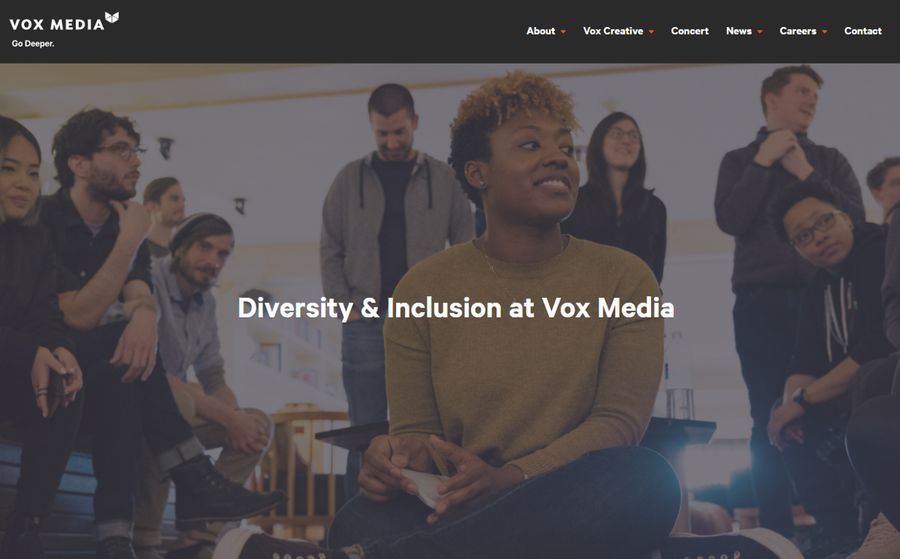How Vox Media’s Product team creates inclusive job listings
Vox Media has grown in the last dozen years from a small network of blogs to become a massive digital media company with hundreds of employees across eight different content verticals. Whether it’s technology, shopping, or sports, Vox Media’s content spans a wide range of topics, and the best way to cover them all is by hiring top talent to make it happen.
We talked recently about how we approach job listing at Fog Creek, so we reached out to Ashley Twaddell, Director of Team Operations & Experience for Vox Media’s Product team, to talk about inclusive language, recruiting efforts, and tools to help companies establish their own processes around creating effective job listings.

Why is having a conversation about job listings important? #
That’s a great question. There are a few reasons. One is simply that it’s in a business’s best interest to actually consider that a job description is an extension of the employer brand, and that’s a powerful tool to market yourself for the talent that you want. It’s important to strike the right tone about what an employer is looking for in candidates, and it’s also about what company values an employer is looking for. A job description is the first thing that a candidate probably sees about the company aside from any other content or product usage that it has, so even if a person doesn’t actually apply for the position, a well-written description can influence that candidate’s opinion of the company, and you get the voice of the company to shine through versus an individual hiring manager’s.
More importantly though, we say here at Vox Media that language actually matters. You don’t want a job listing to make the candidates that you’re trying to attract back away. If you’re focused on attracting a large and diverse pool of candidates, you don’t want that job description to sound exclusionary in any way. If you’re an employer or company that doesn’t understand the benefits of hiring a diverse workforce, both from a moral and a business standpoint, there’s plenty of free resources and reading that you can do to get started.
You joined the Vox Product team back in 2015 as a product team coordinator. What was the state of job listings like? #
We probably had around 500 or 600 full-time employees at the company, and the most notable change we had made in terms of hiring was switching to Greenhouse as our internal candidate tracking application system.
At that point, in terms of the job descriptions themselves, we had one or two template phrases that we would encourage folks to use. Those were generally about what Vox Media is as a whole, what the company does, and then also some blurbs about what working for Vox Media meant, specifically Vox product. There was also a description about our team, and that pointed you to a page where you could see our team blog and our code of conduct. But everything else was all over the place, and at that point, not really tested for inclusion.
We relied heavily on our leadership team to do a lot of the hiring for Vox Product, and honestly, we were really fortunate to have really thoughtful and educated leaders like our former VP of engineering, Michael Lovitt. He really supported and encouraged best practices around this. When you’re growing quickly and you don’t have a system in place with dedicated resourcing to check in on these things, ultimately you won’t be as successful as you hoped.
When I joined the company as a product team coordinator, I routinely checked on our job descriptions and ran them through online editing tools to check for gendered language and the overall tone and shape of our job descriptions. I would do that in coordination with our People and Culture team.

Was there anything in particular that prompted that move to review the language? #
Definitely. In my job description, it was actually listed as one of the first things that I would be responsible for, in addition to a slew of other hiring responsibilities! But honestly, I think that in terms of what actually prompted the move…it was our staff, which is something that I’m really proud to say. So much of our inclusive culture is due to the incredibly thoughtful people we have been able to hire from the beginning, in addition to leadership that’s open and willing to take action on any of the recommendations that our staff would provide.
We have a company diversity leadership group in addition to our own Vox Product diversity group. At that point, the group was comprised of leaders across all the different divisions of Vox Media, and a lot of the initial resourcing came from the contributions of the members of that group, some of which were Vox Product staff and leadership. We recognized as a product team and as a company that building a system for inclusive hiring, starting with the job description, is more than important — it’s the right thing to do. We just had to figure out how to put the practices in place to make sure it was happening at scale.
The general conversation around job listings and inclusive language feels fairly new…like it’s something that’s just started to become more important within the past five to ten years. What sort of steps did you take when it came to the language that Vox Product used with job listings? #
As a team, and as a company, we recognized this was a larger conversation, and that we needed to make improvements to show that it was work that needed to be done and was necessary to change things. A lot of our leadership worked on this versus falling onto our staff itself to create the changes, which I think is important to acknowledge. It demonstrates that as a company, we made it a real priority.
Beyond that, we did our research to see what best practices already existed in terms of what language to add and what language to avoid. We also focused on some of the internal process changes that would need to happen in terms of who is seeing job descriptions, who’s writing them, who’s posting them, and figuring out what resources we might need to ensure that hiring managers would implement these changes as they wrote and posted job listings.
Were there any specific phrases or words that were changed? You mentioned before that you ran the language through certain online tools to check for inclusive language. #
I think generally we were looking to make our listings as a whole just more inviting and exciting. We worked to remove a lot of gendered language and emotional language. We avoided using any gender specific pronouns or terms that sound too aggressive or too feminine. We also asked our teams to avoid listing years of experience or any unnecessary educational requirements. We largely want our hiring managers, when they’re writing the descriptions, to focus on the skills and qualities a person could bring to our team. We take a step back and look at what we call our “scorecard attributes” to build out a list of skills that are truly necessary for the job versus a huge laundry list of nice-to-haves or irrelevant skills for the job.
So if there are nice-to-haves, we ask our hiring managers to state them as such. Are they skills that someone would have to learn through an educational experience, or are they on-the-job skills that you can learn? They aren’t formal requirements, and we ask our hiring managers to list them separately.
What’s been the outcome of these job listing changes as it relates to recruiting? #
The biggest impact that I have seen over the last few years is that it has helped with our company’s reputation for being an inclusive employer; one that actually values having a diverse workforce. We are, after all, a company that prides itself on voices, and as a product team in particular, we’re looking to extend that into how we build thoughtful and inclusive products. So we certainly see an increase in the number of applications that we’re getting. We’re also able to use EEOC data to track within our job listings the identities candidates report them themselves, and we’re able to analyze and make changes to move one way or another. But overall, we’re seeing a general change in the reputation of the company and how people perceive us.
Based on the knowledge that you have now, is there anything that you would have done differently with respect to changing Vox Product’s job listings? #
That’s a good question. I certainly wish we could have gotten to where we are now a lot faster! But it just shows we’re two years later down the road, and there’s still even more work to be done. We wish that we could make those strides a lot faster, obviously.
I think training would have been the most effective thing. For a while, I was coaching managers individually because I had to support them with not only job descriptions, but the whole hiring process: how to use Greenhouse, how to build out an interview kit, how to think about scorecards…that whole ordeal. I was supporting them one-on-one, and that obviously wasn’t scalable. It’s one thing to have documentation that guides you through how to write the steps of an inclusive job description, but ultimately, it’s better if the hiring managers actually understand why, and that they can identify the traps they might get into before they even sit down to write a job description. Taking the time to put together training would have made much more of an impact in the long run.
What resources or tools would you recommend for companies who want to ensure that their job listings are using inclusive language? #
That’s a great question. From an editing standpoint, there are really great, free tools like Textio, Gender Decoder for Job Ads, and Joblint. Those tools help with making quick language checks before a job listing is posted. I really encourage employers to make sure they have taken the time to read and understand the larger conversation that’s at play here and make sure their hiring managers are well versed in the facts, too.
There’s so much great reading and resources out there. Hire More Women in Tech is a great resource to start. There are great voices also, especially in the tech space. Erin Kissane and Brittany Laughlin are two women that share wonderful insights and tools around this type of work.
Ultimately, I think just taking action to ensure that there’s a process that serves both as an educational tool and as a writing tool is a huge first step. Beyond that, make it a company priority to be accountable for the results of an effective job listing. It’s not only better. It’s actually necessary.
_Creating inclusive job listings to attract future employees is a crucial part of any company’s growth and success. Move your career forward and come work with us at Fog Creek_!

